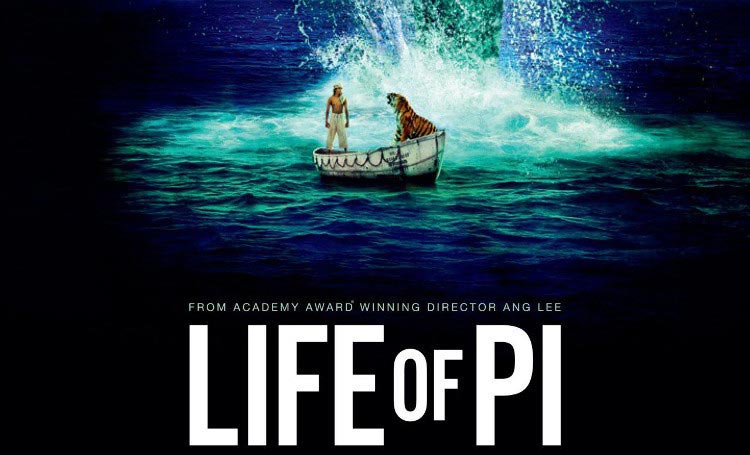Wow, this has been an exciting fall for literary adaptations! I read Yann Martel’s Life of Pi a decade ago and thought it was fantastic storytelling. I cheered when it won the Man Booker Prize. So, I was quite excited to attend an advance screening recently with several members of my book group. I remembered the novel quite well in broad strokes, but not the fine detail. I didn’t refresh my memory before watching the film, but was curious enough to reread Life of Pi in its entirety before writing this review. The film is very true to the novel in spirit and tone, but there are small changes, additions (generally positive), and elisions (some noteworthy).
The film opens similarly to the novel. The idea is the same, but the execution is slightly different. Different mediums require different storytelling tools. For instance, I believe most film-goers will readily recognize The Writer (portrayed by actor Rafe Spall, who replaced a distractingly famous Toby Maguire) as a stand-in for author Martel. In the novel, it is Martel himself, in direct address to readers, who fulfills this role, effectively blurring the line between fact and fiction. It is established that this story is being related to The Writer by an older Pi. From there, readers are introduced to a young Piscine Molitor Patel and the world he inhabits. It’s a charmed childhood, being raised at the Pondicherry Zoo amongst a loving family and exotic animals—an Indian “We Bought a Zoo.” These scenes are as lush and colorful as any Bollywood musical.
I’ve discussed this novel with other readers countless times over the years. It’s beloved by many, but truly hated by a vocal minority. I’ve never understood the vitriol, personally. Martel writes beautifully and accessibly. His story is fast-paced and yet deeply rooted in character. And it explores the boundless subject of faith through an extraordinary tale—a “story to make you believe in God.” But one complaint I’ve heard from readers is frustration over (or lack of interest in) Pi’s religious explorations early in the novel. The young man is a practicing Hindu, Christian, and Muslim. Martel never belabored the point, but those readers will be gratified to see that director Ang Lee has streamlined the beginning of the tale to move more swiftly to the meat of the story.
When I first heard the premise of this novel, somehow I thought Richard Parker would be some kind of cute, anthropomorphized tiger, and oversized puddy tat. He was not. He was a terrifying predator, and he stayed a terrifying predator, throughout Pi’s ordeal. This was much the same in the movie (although not quite to the degree as in the novel, a change commented upon by Martel in the Hollywood Reporter). Richard Parker was scary in the book, but he was terrifying on the screen. I flinched as he snarled and lunged in 3D.
From here, both novel and film take on an episodic or picaresque quality. The film is delightfully dream-like from its opening frames. (An early scene of the swimming pool from which Pi derives his name enchanted me!) But as the days at sea pass, and the ribs of both animals become plainly visible, the film shifts from dream-like to hallucinatory. Episodes and encounters become increasingly extraordinary. Sitting in the audience, I could clearly discern who had read the novel and who had not by the gasps and exclamations. (Among my friends, the film was enjoyed equally by those who had read the book and those who had not.)
Yes, there are episodes that are missing from the film, one of which is quite notable. Fans may miss it. And, yet, I can understand the choices made. Cuts were judicious. As noted earlier there are a few small shifts and changes. But this is a very faithful adaptation of Martel’s novel, and I suspect it will please most fans of the original. What is lost is more than made up for by how Ang Lee has brought Martel’s fantastic vision to life.
The cinematography and design of this film is exquisitely beautiful. I’m not a huge fan of 3D technology, but once in a while it seems to really augment a film. Such is the case here—all the better to experience a small boat on the vast ocean. And while we’re on the subject of technology, the CGI work on the tiger is seamless. None of us could detect where the real tiger ended and the computer-generated beast began. I have heard that young Suraj Sharma never once filmed with the live animal. For safety, their scenes were filmed separately. And I don’t know how much footage was of a real cat. All I can say is that the illusion is extraordinarily believable. That a first-time actor could give such a convincing performance playing opposite an imaginary tiger is doubly impressive. The success of the film lies firmly on Sharma’s moving portrayal of 16-year-old Pi, but the supporting performances were equally strong. It was Spall’s response to Pi’s story at the end of the film that actually gave me chills.
 |
| President Barack Obama's note to Yann Martel after reading Life of Pi. |


